Plumerias are so exotic and beautiful that it seems like they would be difficult to care for. But they’re actually quite easy to grow once you learn how.
In this post, I’ll tell you all you need to know about how to grow plumerias, including water, soil, fertilizer, and light, as well as tips one propagating, pruning, flowering, and more.
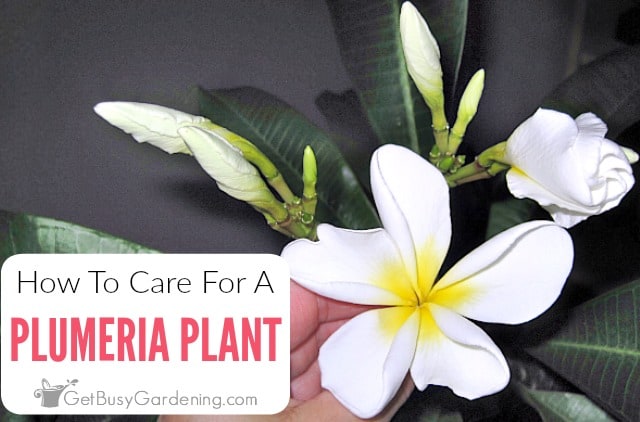
When I think back to my trips to Hawaii, one thing that I remember the most was all of the gorgeous plumerias growing and blooming everywhere.
So of course, I absolutely had to bring one home with me when I went back to Minnesota.
My new baby Hawaiian lai plant was only about a foot tall when I got it, and it bloomed shortly after I brought it home.
I instantly feel in love, and was pleasantly surprised by how low maintenance it was. If you want to try one for yourself, then you’re in the right place.
Below I’ll tell you everything you need to know about their care, and show you how to grow plumeria no matter where you live.
Plumeria Quick Care Overview
| Scientific name: | Plumeria |
| Classification: | Tropical plant |
| Common names: | Frangipani, Hawaiian Lei Plant, Kalachuchi, Champa Flower |
| Hardiness: | Zones 10+ |
| Temperature: | 60-75°F |
| Flowers: | Colors and bloom times vary by species |
| Light: | Full to partial shade, bright light indoors |
| Water: | Allow soil to dry slightly, do not overwater |
| Humidity: | Moderate to low |
| Fertilizer: | Flowering plant food in spring and summer |
| Soil: | Fast-draining, fertile soil |
| Common pests: | Spider mites, whiteflies |
Information About Plumerias
Plumerias are popular tropical plants that can grow into huge trees in their native environment.
You might know them better as a Hawaiian Lei Plant (plumerias are the type of flowers traditionally used to make leis), or maybe by their less common name, Frangipani.
But don’t let their common name fool you, they aren’t actually native to Hawaii. They’re originally from the tropical regions in Central and South America, as well as parts of the Caribbean.
Different Types Of Plumeria
There are several different varieties of plumerias, some can become large trees, while others are smaller shrubs. But they all require the same care and attention. Here are a few of the most common.
- Plumeria pudica – Also known as Bridal Bouquet because of the white flowers, this is one of the hardier varieties that can survive down to zone 9. It can reach 15-20′ tall.
- Plumeria rubra – This is one of the more common types, and there are several hybrids. Depending on the cultivar, they can grow anywhere from 6-30′. The flowers come in just about any color too, and some can bloom year round.
- Plumeria obtusa – There are a few cultivars of this one too, many of which are shorter dwarf varieties. Colors and bloom times also vary between them.
- Plumeria alba – Sometimes commonly called a Nosegay Tree, this species is another one that can grow 6-30′ in height.
Flowers
As I’m sure you probably already know, plumeria is prized for their gorgeous, and highly fragrant flowers.
Depending on the species, they can be just about any color, and some individual blossoms even contain more than one.
The time of year totally depends on the variety. Some only flower in late winter through spring or summer, while others will bloom profusely all year long.

Toxicity
The sap can cause irritation for those with sensitive skin, and is also toxic to cats, dogs, and people if ingested.
Though they’re only mildly poisonous, it’s best to keep them out of reach of your kids and pets if this is a concern for you. The ASPCA website is a great source for more information.
How To Grow Plumeria
Before we jump into the details of plumeria plant care, first we should chat about where to grow them. Choosing the right location is key to long-lasting, sustained health.
Hardiness
Most frangipani plants can only live outdoors in zones 10 or higher, though there are few that can survive down to zone 9.
They’re very sensitive to the cold, and will drop their leaves or turn yellow or brown in the fall, even in warmer areas.
Where To Grow Plumeria Plants
In warm enough climates, plumerias can grow into very large trees, so they will need a lot of space in your yard.
If you want to restrict their size, you can put them in a container instead of in the ground, they do very in pots.
They can also thrive indoors in a spot with plenty of light. Although it’s very uncommon for them to bloom inside the house.
For that reason, I find it’s much easier to put them outside in the summer to maintain their health and growth, and also encourage flowering.

Plumeria Plant Care & Growing Instructions
With the proper care, plumerias can live for many years. Now that you know where to plant them, let’s chat about their needs. Follow these tips to keep your plumeria growing and blooming year after year.
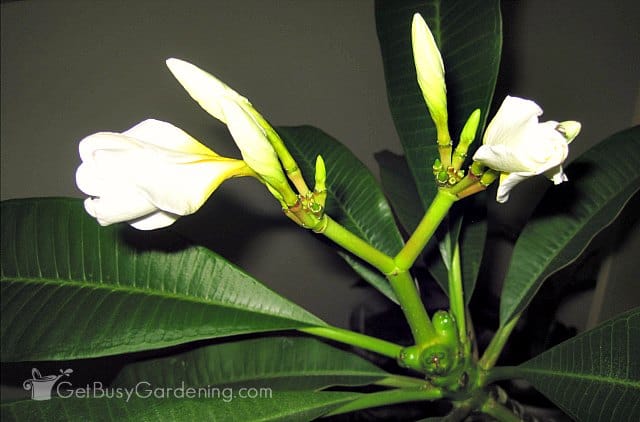
Watering Requirements
Plumerias like a lot of water, but won’t tolerate being overwatered. When they’re too wet, the trunk will rot, and it will eventually kill the plant.
It’s kind of a funny combination, give it a lot of water… but don’t overwater? I know, but don’t worry it’s actually pretty easy. A moisture gauge will help you get it right.
During the summer months, give it a really good, deep drink. Allow the excess to drain completely, and wait until it’s mostly dry before adding more.
Since they go dormant during the winter, it’s best to water them very sparingly, if at all, during those months.
Humidity
You might be surprised to learn that plumeria plants prefer moderate to low humidity levels.
If it’s extremely dry in your home, you can place a humidifier next to it to help add extra moisture to the air.
However, be careful misting or spraying them with water, you don’t want to overdo it. If droplets are constantly sitting on the branches or leaves, it could cause them to rot.
Light Requirements
Plumerias need full sun in order to grow their best and also to bloom, otherwise they will become sparse and leggy.
If yours is outside, put it in a full sun location. Otherwise if it’s indoors year round, then you’ll likely need to get a grow light.
When you move it outside for the summer, don’t give it full exposure right away, or it could burn. Instead, put it in the shade for a few days, and gradually introduce it to a full sun location.
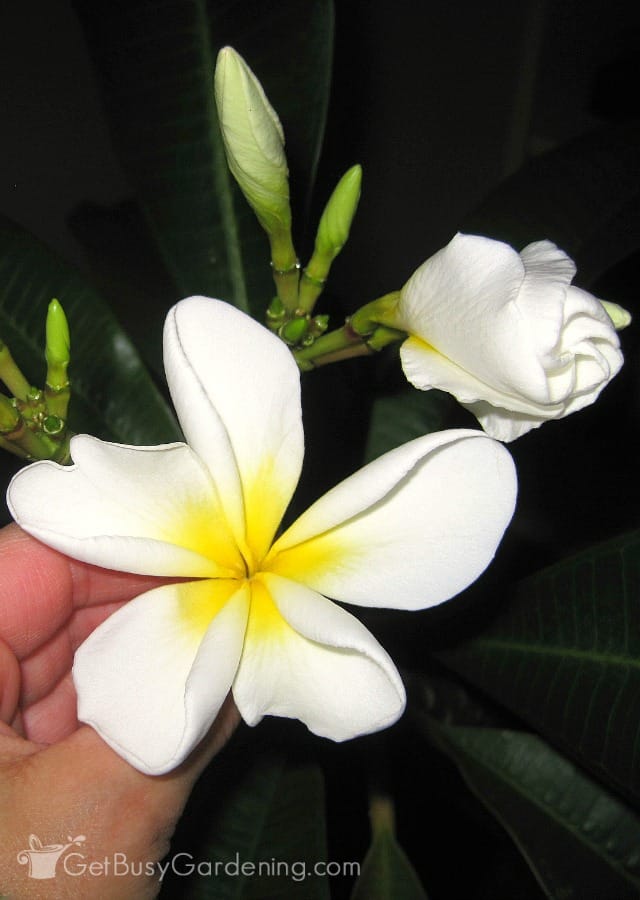
Temperature
Plumerias are not cold hardy plants. Their ideal temperature range is between 60-75°F.
If it gets much colder, they’ll start dropping their leaves, and below freezing temps will quickly kill them. Even a light frost can damage the tender branch tips.
Hotter weather doesn’t often bother them, though the high heat in arid climates will dry them out too quickly.
Best Soil
The best soil for successful plumeria plant care is a fast draining mix that’s slightly acidic, ranging between 6-7 on a pH meter.
You don’t necessarily need to buy any special type, and you can even make your own if you want.
I grow mine in a homemade mixture of 2 parts general purpose soil with 1 part each of either perlite or pumice, and sand.
Find out more about how to choose the best soil for your plumeria, including my recipe to make your own in my detailed guide.
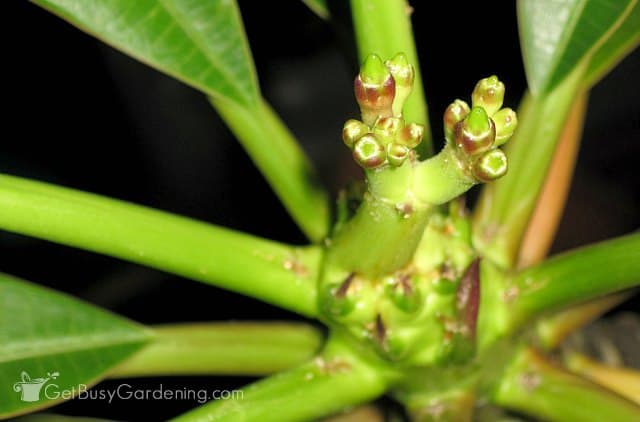
Fertilizer
As I already mentioned, plumerias are very heavy feeders, and fertilizing is an important part of their care.
They need a type that is high in phosphorus in order to bloom. Apply an organic liquid flower food every 1-3 weeks in the spring and summer. You can also apply granules monthly to provide even more nutrients.
Fertilize them from spring through summer, and stop in early fall. Then don’t feed them at all during the winter.
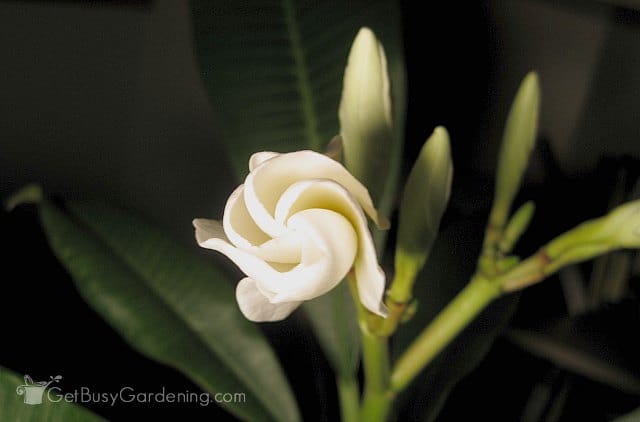
Repotting
With the proper care, frangipani trees can grow very rapidly, and may need repotting every 1-2 years.
When roots begin to come out of the drainage holes, or growth slows, it’s a sign they need to be sized up.
In the spring, move them into a container 2-4” larger than the current one. Replant it at the same depth, and expect some leaf drop or drooping as they recover.
If you want to limit their size, simply refresh the top few inches of soil and trim away some of the roots.
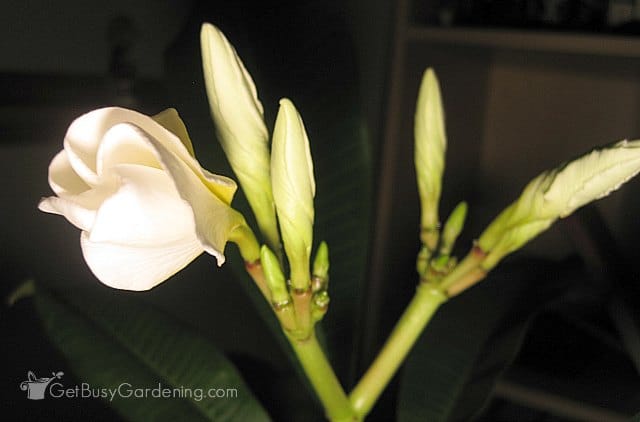
Tips For Controlling Plumeria Pests
Though pests aren’t usually an issue outdoors, plumerias can have problems with spider mites and whiteflies indoors.
If yours gets attacked by bugs, begin treating it right away. I recommend using neem oil, which is a natural pesticide that works great.
Organic insecticidal soap is also a good option. I sometimes make my own by mixing 1 tsp mild liquid soap per 1 liter of water.
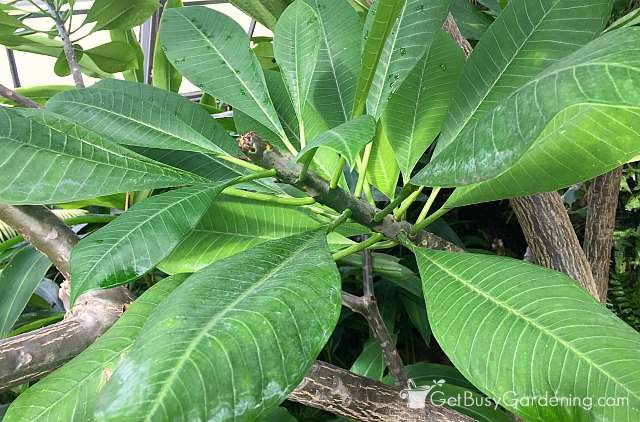
Pruning
Plumeria plants benefit from regular pruning as a part of their care routine. They can handle being trimmed back pretty severely, but never cut them all the way down to the ground.
The best time to do it is in the spring, or right after they’re done blooming.
Use sterile and sharp pruning shears so you get a nice clean cut. For thicker branches, you may need to use a lopper. Also, wear eye protection and gloves to protect against the sap.
Always make your cuts at a downward angle, so water can’t settle into the wound and cause the branch to rot.
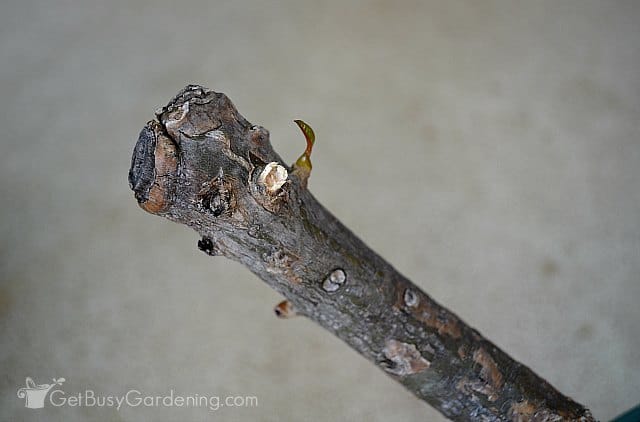
Plumeria Propagation Tips
Though they can be grown from seed, most home gardeners propagate their plumeria by taking cuttings.
It’s pretty easy to do. Simply take a section from a healthy branch, remove the flowers and leaves, and allow it to cure for several days.
Dip the cut end in rooting hormone, then place it into a slightly moist medium. Keep it in a warm spot until you see new growth on top. Get my step-by-step tutorial for how to propagate the cuttings here.
Plumeria Winter Care & Dormancy
Once the temperature starts to cool in the fall, and there’s less sunlight, your plumeria will start to go dormant naturally. This is the time to stop fertilizing, and slow down on watering.
The leaves will turn yellow and then brown before finally dropping off. This is totally normal, so don’t panic. It might not drop all of the leaves though, and that’s ok too.
If you live in a cold climate, this makes is much easier to overwinter them indoors. So there’s no need for artificial lights or a sunny window.
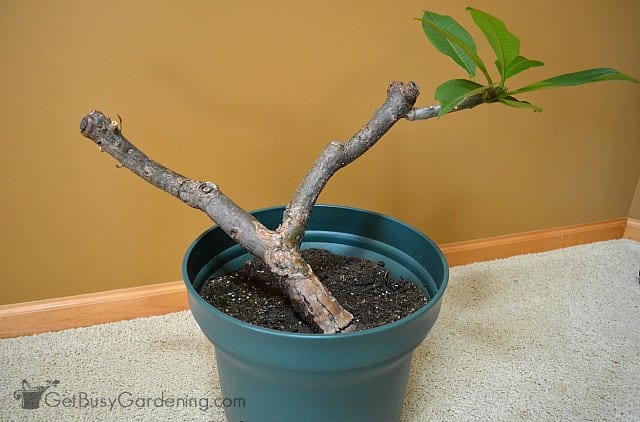
Troubleshooting Common Plumeria Care Problems
Though plumeria are fairly simple to care for, they are notorious for having a few problems. Below I’ll help you troubleshoot and fix the most common issues.
Tip Rot
In my experience, tip rot is a pretty common problem. It happens when water settles in a crack or wound on the end of a branch, which is usually caused by improper pruning or frost damage.
If left untreated, the rot will spread, and could eventually kill the plant. You can save it by cutting off all of the rotted pieces of the affected branch.
Stem Rot
If the stem is mushy and rotting at the base, then you have a more serious problem. Stem rot is caused by overwatering.
If left untreated, your plant will die for sure. If the rot isn’t too severe, you can save it by taking cuttings of the healthy stems or branches and rooting them.
Plumeria Won’t Bloom
This is probably the #1 question I get asked about growing plumerias, and there is one simple answer… fertilizer.
They need fertilizer in order to bloom, and lots of it. The good news is that it’s such an easy fix. Once you get the hang of it, they will flower profusely for you.
Leaves Falling Off / Dropping
Leaf drop can be caused by a lack of water or cold temperatures. It’s natural for them to go dormant during the winter when it gets below 50°F, and this is nothing to worry about.
However, if it happens during the summer, then check to make sure they’re getting enough water. They should never dry out completely. Also inspect the branches and trunk for signs of rot.
Leaves Turning Yellow
Yellow leaves are also a sign that they’re starting to go dormant, however it could be from overwatering, pests, or disease.
Check the soil to make sure it’s not wet or soggy, inspect the leaves for bugs, and verify that the stems are firm and not rotting.
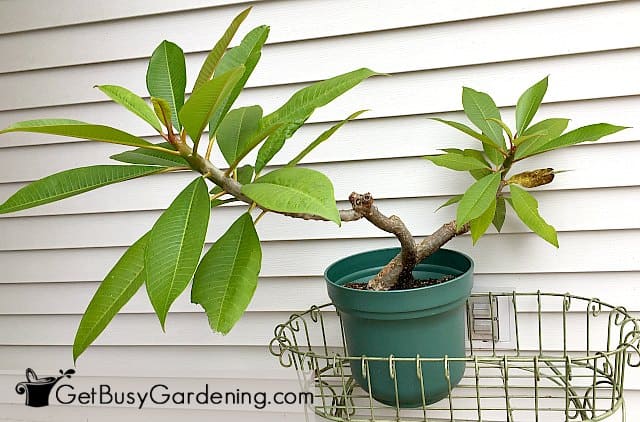
FAQs
In this section I’ve answered some of the most frequently asked questions about plumeria care. If yours isn’t listed, please ask in the comments below.
Are plumeria hard to care for?
No, plumeria are not hard to care for. They’re actually quite easy to grow, as long as you understand their requirements.
How long does it take for a plumeria to be full grown?
How long it takes for a plumeria to be full grown totally depends on the variety. Some grow must faster than others, though on average they can put on 12-36″ per year with the proper care.
Is plumeria an indoor or outdoor plant?
Plumeria can be either an indoor or outdoor plant, depending on where you live. They’re only hardy in the warmest regions, so people in cold climates must bring them indoors during winter.
Is plumeria a succulent?
No, technically plumeria is not a succulent, they are tropical plants. Though they do have some similar care requirements and properties.
Is frangipani the same as plumeria?
Yes, frangipani is the same plant as plumeria. Frangipani is the common name for them. Plumeria is technically the scientific name, though many people also call them that since it’s easier to pronounce.
Plumerias are wonderful plants that are surprisingly easy to care for. Once you know the tricks for growing them, you’ll be able to keep yours thriving for decades to come.
If you want to learn all there is to know about maintaining healthy indoor plants, then you need my Houseplant Care eBook. It will show you everything you need to know about how to keep every plant in your home thriving. Download your copy now!
More Houseplant Care Guides
- How To Grow Begonia Plants
- Wandering Jew Plant Care & Growing Guide
- African Milk Tree: How To Grow & Care For A Euphorbia trigona Plant
Share your plumeria plant care and growing tips in the comments section below.


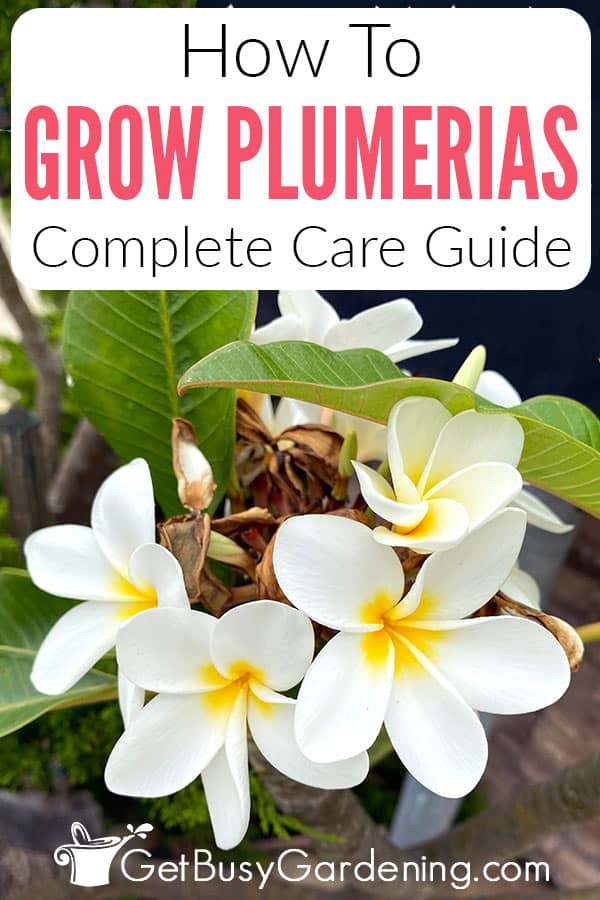
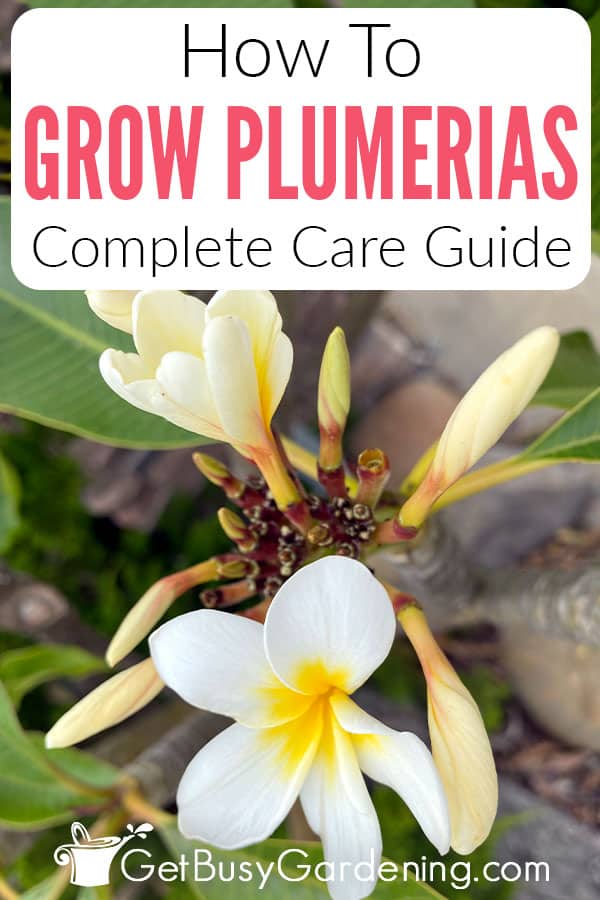
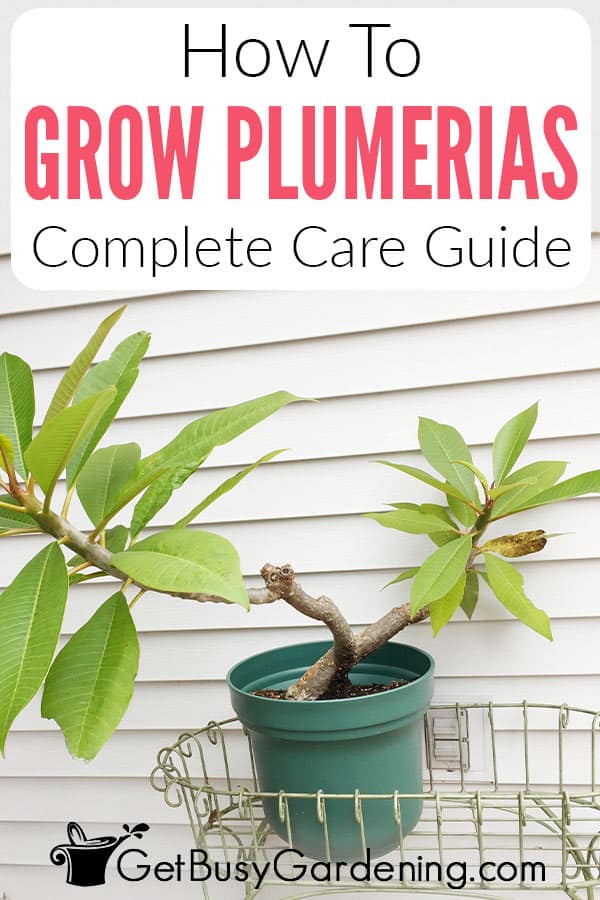
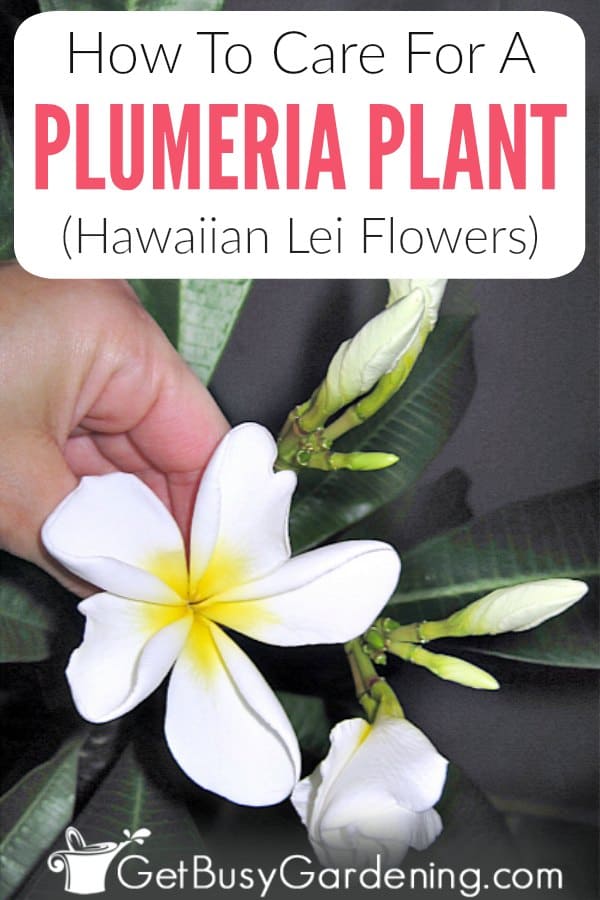



Nic says
Great advice, thanks so much! I need to get moving on this as they are starting to show signs of life at the tips. I just really hope I can separate them without killing them as they have been doing so well, considering it was my very first try at rooting cuttings. I haven’t had any flowers yet, but after reading your tips, I will be fertilizing much more than I was. How long after repotting, and the stress of that on the plant, would you recommend starting to fertilize them? Thank you again for your help!
Amy Andrychowicz says
I would wait until new growth starts to grow on the plumeria plants before you start fertilizing them after repotting them.
Nic says
Hi Amy! I’ve enjoyed reading your tips and all the questions and answers. I have several (7) 3-year old plumeria cuttings growing in one 12 inch pot. Due to moving around the past few years, I never got around to separating the cuttings and potting them in their own pots. They are about 3 ft tall and have done well, but I’m positive they are VERY root-bound. I would love to repot them, but I’m afraid they won’t like having the roots messed with. Do you have any suggestions on how to proceed?
Amy Andrychowicz says
Yes, I would definitely recommend repotting them. The best time to repot plumerias is in the spring, just before they start to break dormancy. If you want to separate the plants into their own containers, then you can gently tease the roots apart after you pull the entire rootball out of the pot. Just be careful that you don’t use too large of a pot for them, to prevent overwatering. If you pot up each of the baby plumerias into separate pots, I would use a pot that is slightly larger than their rootball. Once they’re established in their new pot, then you can pot them into a bigger one next spring if necessary.
Doreen Mohler says
Hi Amy. You have a lot of awesome plumeria information. Thank you! I️ have 2 beautiful plumeria that my Daughter-in-law gave me from cuttings of her mother’s plants in Southern California. I️ live in Northern California and need to bring my plants inside during the winter. My problem is that they are getting so big that it’s hard to move them and find space for them in my home. My question is, when is the best time of the year to propagate them? I’ve been wanting to propagate them but am a little scared. Any insite you can give me would be greatly appreciated. My plants are about 4 years old.
Amy Andrychowicz says
Thanks, glad you enjoyed the details about plumeria plant care. The best time to take cuttings for propagating plumerias is the spring. You can find detailed plumeria propagation instructions here.
Pat Losack says
Hi, I brought back two cuttings from Hawaii in April. I planted them a enjoyed their beauty all summer. Both bloomed from the end of June until a couple weeks ago. They are outside here in Holly Springs, GA. I have noticed that the leaves are starting to turn a little yellow and have brown spots on them. I will be bringing them in this evening because of the temp.
What could be causing the spots and yellowish color? Pictures available if needed
Please and thanks,
Pat
Amy Andrychowicz says
The plant is probably going dormant, which is totally normal. During the winter, plumeria plants go dormant and usually drop all of their leaves (although they don’t always drop the leaves). Read the section in this article titled “Plumeria Winter Care & Dormancy” for more details.
Danielle says
I have a plumeria, in East Texas, on the leaves there is a white powdery substance in the middle of the leaf. this was a cutting off of a tree that has bloomed before, the flowers were pink and white. i guess that I had not fertilized it enough, since it has not bloomed. But my question is what is the white powder, and how do I get rid of it. it is November here. and I have brought it in the house if the temp is going to me below 60*
it is funny in Hawaii they grow like wildfire, with very little care.
Thank you very much
Danielle
Amy Andrychowicz says
That white powder might be mealybugs, here’s how to get rid of them… How To Kill Mealybugs On Houseplants
Danielle Harris says
Thank you for the answer for the white powdery on my plumeria plant.
Amy Andrychowicz says
You’re welcome!
Cathy Patterson says
My plumeria has two very long, heavy “spikes” coming off of a branch. Could there be seeds in these pods? They are different than the flower blooms and leaves.
Amy Andrychowicz says
How fun! Yes, plumeria plants can grow seeds, and you can collect those seeds and plant them too. 🙂 Allow the seeds pods to dry on the plant before collecting them. Plumeria plant seeds don’t store very well, so plant them as soon as you can after collecting them. Good luck!
Patrick Rajman says
I have purchased a couple plumerias that have single stem and I would like to start splitting it to branch off, the plumeria have been growing for a few months now and are about 2 ft tall now. Is it okay to just cut them at the top at this point? I do have them in pots outdoors in Phoenix az. I also noticed the leaves are getting burnt often, I keep them under the patio and get western sun exposure a fee hours a day. I am now watering them every few days and curious if they need more often water, soil seems not dry. I did use the cacti soil for the points for draining and fertilized them using dr.earth plumeria blend.
Amy Andrychowicz says
If your plumeria plants are established in their pots (rather than being brand new cuttings), then yes, you can prune them to encourage branching. Just be sure to make your cuts at a downward angle so that water cannot settle on the top of the wound.
I have a feeling the leaves on your plumeria are burning because they are being exposed to the hot afternoon sun. Since the sun is so intense in AZ, I would definitely recommend keeping them in a place that gets filtered sunlight. A spot that gets early morning and/or evening sunlight, where your plumeria will be protected from the intense afternoon sun is ideal.
As for watering, definitely let the soil dry out a bit more between waterings. You don’t want it to stay moist all the time or the stems could start to rot.
Bob Leman says
Amy, we have a small plumeria plant that started as a cutting this spring. it’s in a small pot and as we are in KS we brought it inside and now it is probably going dormant. it may be root bound, should we repot it or leave it til spring. If you recommend repotting, how big of pot and is peat moss ok to add to potting mix.
Amy Andrychowicz says
I would definitely wait until spring to repot your plumeria. Let it go dormant this winter, then repot it when it starts to wake up in the spring. You can use a general purpose potting soil, but plumerias don’t like sitting in moist soil. So, if you have trouble with overwatering, I would recommend using a mix with better drainage (like a succulent soil mix). As for the pot size, I recommend going only one pot size up from the one it’s growing in. So, for example, if your plumeria is currently growing in a 4″ pot, then I would repot it into a 6″ pot.
Bob Leman says
Amy, Thank you for your response, my wife cares for the plant, she says it is still growing(new leaves). We have it indoors and we keep our home in the upper 70’s due to health issues. what would suggest. Thank you again Bob
Amy Andrychowicz says
You’re welcome!
Carol says
My plumeria plants are a mess. They branched out with very little leaves. In fact the branches has branched more branches in different direction. I live in North Carolina and bring my plants are n for the winter. Would it be possible for me to “REALLY ” cut it back and start over now?
Amy Andrychowicz says
Yes, you can prune your plumeria, and remove some of the longer branches if you want to keep it more compact if that’s what you’re trying to do. Just be sure to make the cuts at a downward angle so water can’t get into them and cause rot. Also, keep an eye on your plumeria after you prune it to make sure the wounds callus over, and check for rot. Tip rot is really common with plumeria, and newly pruned plants are the most at risk.
Gay Doyle says
Hi, Amy, I have a double trunk plumeria that is 6 feet tall. It has never bloomed despite over 8 hours of sun spring-summer and regular fertilizing. I got it as a small cutting 4 years ago. It has been in the same large pot for 3 years. Should I repot and change potting soil? Do they get rootbound and is this good or bad for blooming. We bring it in every winter to go dormant and put outside each spring. I use osmocote super bloom. Thanks for any help.
Gay
Amy Andrychowicz says
Yes, if your plumeria is pot-bound, then I would recommend moving it up to a larger pot. Plumeria plants don’t bloom well when they are pot-bound. Also, it would be better to fertilize it using a liquid fertilizer, rather than a granular one, and they should be fed weekly during the summer months.
Gay Doyle says
Thanks, I think I will wait until spring and then do as you suggested.
Amanda says
My plumeria is dropping it’s leaves. I read that they do go dormant and the leaves turn yellow and drop, however my leaves are still green and beautiful, however they are falling off that way too! I do not like to see these big beautiful green leaves on the ground, what does this mean?
Amy Andrychowicz says
Yes, usually when plumeria leaves fall off for dormancy, they turn yellow and/or brown first. I would check the entire stem and all the branches of your plant to make sure it’s not mushy at all. If that looks good, then check under the leaves and at the leave joints for signs of bugs. Otherwise, did your plumeria plant get moved or exposed to extreme temperatures recently?
MARIA J FOSS says
Hi my name is Maria and I am new to Plumeria crop. I currently have seven plants. I have read a lot learned from you and the comments, but I have been surprised no get any information about the plague that is widespread in all Plumerias. I live in Florida and it is a commom plant in the city where i live Sarasota, and on most plants i see the leaves are yellow, they have a yellow power that completely covers them completely underneath them, I have two in this condition, what I do is remove the leaves, but they appears again and refill of that dust. The plants does not stop growing but it does not bloom. For that conditionI decided to look for information on the internet and i got your page I would be grateful if you could advise my.
Amy Andrychowicz says
It sounds like plumeria rust to me, but it’s always a good idea to bring an infected leaf to your local garden center to have them ID it for you. The best way to prevent the spread of plumeria rust is to remove the infected leaves and destroy them (burn or throw them into the garbage, don’t compost them). Be sure to clean up all fallen leaves and get rid of those too. Then make sure your plumeria gets enough airflow, and isn’t being crowded by other plants. Moisture on the leaves is the most common way to spread fungal diseases on plants like plumeria.
lisa williams says
My plumeria is finall budding after having it for a few years! THe problem I am having is that the flowers barely open then fall off 🙁
Amy Andrychowicz says
Bummer! Can you give me more details about your plumeria plant? Have you moved the plant recently? Did the temperature get cooler? Is it outside or indoors? How much light is it getting? Are you fertilizing it?
Ran says
Hello Amy, and thanks for the tips as always.
I need help please with my Plumeria!!
I’ve bought it about 3 weeks ago, put it in my office, and I think it’s doing mostly fine since then.
Well honestly the conditions in my office is not very plants-friendly, no sun at all, artificial light only, and it can get very humid sometimes, and I’m desperately trying to find a plant that can live there. Plumeria is new to my experience, and I’ve read it can tolerate low light, what happened is: we had 4 days holiday, I was afraid it will get thirsty during this time, so I put more water, when I got back today I found it mostly doing fine, except for one leaf that has dark areas around its edges, so my status now is: freaked out!.. did I overwatered it? knowing that I tested the soil and it was completely dry!.. does it need sun now? should I bring it back home where I have a good sunny window? (dump question probably)… hope it’s not a kind of rot!
Thank you very much!
Just a further info: the climate where I live in general is very hot and dry in summer, and freezing in winter but with good humidity, I don’t have a garden so it will be kept inside over the year.
Amy Andrychowicz says
It might be starting to go into dormancy. Like other types of trees, plumerias go dormant and drop their leaves during the winter in their natural environment. I find it easier to grow my plumeria indoors by allowing it to go dormant in the fall, and then putting it outside during the summer. Plumerias do need a lot of light, so if the artificial lights in your office aren’t enough, then you might want to consider brining it back home and keeping it in a sunnier spot, or getting a grow light. Here’s a list of great low light indoor plants that could thrive without windows in your office space… 20 Low Light Indoor Plants That Are Easy To Grow
Elaine Spikes says
I purchased a plumeria branch in Hawaii. I live in Roseville, CA which can get very hot. Today it may reach 110. Anyhow, I live in an apartment and keep my starter plant on the balcony out of the direct sun. It gets plenty of direct sunlight. I am really concerned about the heat so I brought the plant inside until later when the temperature drops. Does anyone have any suggestions? Should I leave the plant outside or what? It is just starting to grow. I have noticed that the top is growing and the lower branch has gotten narrower. Is that normal?
Amy Andrychowicz says
Plumerias are hardy in zones 10-11, so they like the heat. I’ve seen them growing in southern CA right in the ground (which makes me super jealous!). As long as your plant is used to being outside, then it should be just fine in the heat. If you start to notice any signs of scorching, then you could move it to a spot that gets partial shade rather than full sun. As for the lower branch getting smaller… check to make sure that branch is not mushy and rotting. If it is, then prune it off until you see healthy new growth. Tip rot is super common with plumerias.
Velvet says
Hello, I have a peppermint plumeria. I successfully have grown 38 plants from seedlings that I harvested from my own seed pods. Wow! I feel very accomplished. Summer is coming close to end and all my babies have between 5-10 true leaves. I live in Zone 8. My question is, should I allow all the babies to go dormant and If not then how would you suggest I keep them from it? I am very seasoned with caring for my mother tree but not all of the babies appear to be the same breed. Thank you!
Amy Andrychowicz says
Woohoo, congrats on being so successful with growing your plumeria from seed! That’s awesome! It would definitely be easier to allow the babies to go dormant naturally. Treat them just like you would the mother plant, but I would give them a tiny bit more water than you would the mother.